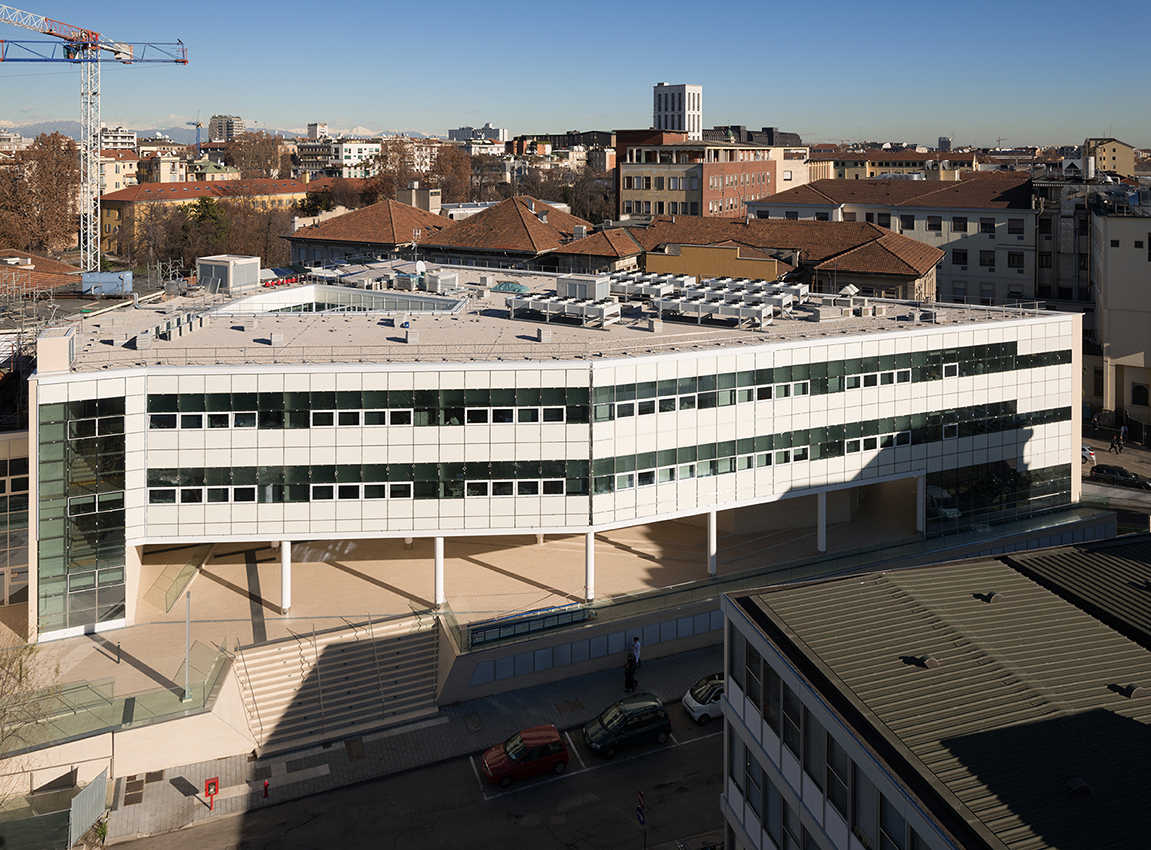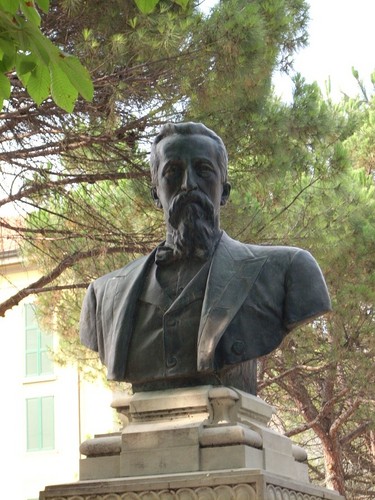|
Policlinico Of Milan
The Policlinico of Milan ( it, Policlinico di Milano) also known as Ospedale Maggiore di Milano or Ca' Granda Ospedale Maggiore Policlinico, is one of the oldest hospitals in Italy, founded by Duke Francesco Sforza in 1456. Today it is a modern hospital with 900 beds, with wards for adults, pregnant women and children. During the first COVID-19 breakout in March 2020, 300 of those beds were readapted for COVID-19 patients. There are three emergency rooms for different categories of patients. The maternity ward (Mangiagalli Clinic) has the highest number of births in Lombardy. The Foundation is a scientific Institute for Research, Hospitalization and Health Care (IRCCS), which means that, alongside clinical activity, it promotes research programs with predominantly translational purposes. The programs are concerned with the rapid transfer of therapies from the laboratory to patients. Organization As of 2020: *President: Marco Giachetti (appointment 2019–2023) *General Director ... [...More Info...] [...Related Items...] OR: [Wikipedia] [Google] [Baidu] |
Lombardy
Lombardy ( it, Lombardia, Lombard language, Lombard: ''Lombardia'' or ''Lumbardia' '') is an administrative regions of Italy, region of Italy that covers ; it is located in the northern-central part of the country and has a population of about 10 million people, constituting more than one-sixth of Italy's population. Over a fifth of the Italian gross domestic product (GDP) is produced in the region. The Lombardy region is located between the Alps mountain range and tributaries of the Po river, and includes Milan, the largest metropolitan area in the country, and among the largest in the European Union (EU). Of the fifty-eight UNESCO World Heritage Sites in Italy, eleven are in Lombardy. Virgil, Pliny the Elder, Ambrose, Gerolamo Cardano, Caravaggio, Claudio Monteverdi, Antonio Stradivari, Cesare Beccaria, Alessandro Volta and Alessandro Manzoni; and popes Pope John XXIII, John XXIII and Pope Paul VI, Paul VI originated in the area of modern-day Lombardy region. Etymology The name ... [...More Info...] [...Related Items...] OR: [Wikipedia] [Google] [Baidu] |
Navigli
The navigli (; lmo, Navili ) are a system of interconnected canals in and around Milan, in the Italian region of Lombardy, dating back as far as the Middle Ages. The system consists of five canals: Naviglio Grande, Naviglio Pavese, Naviglio Martesana, Naviglio di Paderno, Naviglio di Bereguardo. The first three were connected through Milan via the ''Fossa Interna'', also known as the Inner Ring. The urban section of the Naviglio Martesana was covered over at the beginning of the 1930s, together with the entire Inner Ring, thus sounding the death knell for the north-eastern canals. Commercial carrying continued on the Naviglio Grande, but the decline was steady and by the 1960s a project of a fluvial port to reach the Po River and consequentially the Adriatic Sea through the canals was shelved for good. Today, the canals are mostly used for irrigation Irrigation (also referred to as watering) is the practice of applying controlled amounts of water to land to help grow Crop, ... [...More Info...] [...Related Items...] OR: [Wikipedia] [Google] [Baidu] |
Caesarean Section
Caesarean section, also known as C-section or caesarean delivery, is the surgical procedure by which one or more babies are delivered through an incision in the mother's abdomen, often performed because vaginal delivery would put the baby or mother at risk. Reasons for the operation include obstructed labor, twin pregnancy, high blood pressure in the mother, breech birth, and problems with the placenta or umbilical cord. A caesarean delivery may be performed based upon the shape of the mother's pelvis or history of a previous C-section. A trial of vaginal birth after C-section may be possible. The World Health Organization recommends that caesarean section be performed only when medically necessary. Most C-sections are performed without a medical reason, upon request by someone, usually the mother. A C-section typically takes 45 minutes to an hour. It may be done with a spinal block, where the woman is awake, or under general anesthesia. A urinary catheter is used to drain ... [...More Info...] [...Related Items...] OR: [Wikipedia] [Google] [Baidu] |
Edoardo Porro
Edoardo Porro (1842–1902) was an Italian obstetrician and gynaecologist, mainly known for developing Porro’s operation, surgical procedure precursor of the modern Caesarean section. Biography Early life Edoardo Porro was born in Padua on September 13, 1842 from Anna Maria Cassola and his father Giovanni who had been transferred there as a Land Registry engineer, and he died in Milan on July 18, 1902. He was raised in Milan where he went to “Ginnasio Liceale dell' Arcidiocesi” and he enrolled in 1860 in medical school at the University of Pavia, where medical luminaries were teaching. Porro went through his university years without being a student of any particular merit; in fact he barely passed the exam of Human Anatomy, which constitutes the basic foundation of a surgeon, scoring only eighteen over thirty. He obtained his M. D. in August 1865 at the University of Pavia, at the age of twenty-three. Military service After his graduation and after a brief ... [...More Info...] [...Related Items...] OR: [Wikipedia] [Google] [Baidu] |
Pneumothorax
A pneumothorax is an abnormal collection of air in the pleural space between the lung and the chest wall. Symptoms typically include sudden onset of sharp, one-sided chest pain and shortness of breath. In a minority of cases, a one-way valve is formed by an area of damaged tissue, and the amount of air in the space between chest wall and lungs increases; this is called a tension pneumothorax. This can cause a steadily worsening oxygen shortage and low blood pressure. This leads to a type of shock called obstructive shock, which can be fatal unless reversed. Very rarely, both lungs may be affected by a pneumothorax. It is often called a "collapsed lung", although that term may also refer to atelectasis. A primary spontaneous pneumothorax is one that occurs without an apparent cause and in the absence of significant lung disease. A secondary spontaneous pneumothorax occurs in the presence of existing lung disease. Smoking increases the risk of primary spontaneous pneumothora ... [...More Info...] [...Related Items...] OR: [Wikipedia] [Google] [Baidu] |
Carlo Forlanini
Carlo Forlanini (11 June 1847 – 26 May 1918) was a medical doctor and professor at the Universities of Turin and Pavia. He was also the inventor of artificial pneumothorax, which was the primary treatment method of pulmonary tuberculosis for the first half of the 20th century and remained in use for severe cases of tuberculosis into the 1970s. Early life Carlo Forlanini was born in Milan on 11 June 1847, the eldest of four brothers and one sister. His father, Giuseppe Forlanini, was a physician belonging to a bourgeosie family of Milan. His mother, Marianna Rossi, died of pulmonary phthisis. Forlanini attended secondary school in Como, received his pre-doctoral education at Calchi Taeggi in Milan, then attended the Borromeo College at the University of Pavia. He interrupted his medical studies in 1866 to serve under Garibaldi as part of Garibaldi's unification of Italy. Forlanini participated in the Battle of Monte Suello and the Bezzecca. After his return to Pavia he pu ... [...More Info...] [...Related Items...] OR: [Wikipedia] [Google] [Baidu] |
Authority
In the fields of sociology and political science, authority is the legitimate power of a person or group over other people. In a civil state, ''authority'' is practiced in ways such a judicial branch or an executive branch of government.''The New Fontana Dictionary of Modern Thought'' Third Edition, Allan Bullock and Stephen Trombley, Eds. p. 115. In the exercise of governance, the terms ''authority'' and ''power'' are inaccurate synonyms. The term ''authority'' identifies the political legitimacy, which grants and justifies the ruler's right to exercise the power of government; and the term ''power'' identifies the ability to accomplish an authorized goal, either by compliance or by obedience; hence, ''authority'' is the ''power'' to make decisions and the legitimacy to make such legal decisions and order their execution. History Ancient history, Ancient understandings of authority trace back to Ancient Rome, Rome and draw later from Catholic (Thomism, Thomistic) thought and ... [...More Info...] [...Related Items...] OR: [Wikipedia] [Google] [Baidu] |
Sesto San Giovanni
Sesto San Giovanni (; lmo, Sest San Giovann, label=Western Lombard ), locally referred to as just Sesto ( lmo, Sest, links=no), is a ''comune'' in the Metropolitan City of Milan, Lombardy, northern Italy. Its railway station is the northernmost stop on the Milan Metro M1 line. The comune has the honorary title of city, despite being a ''de facto'' suburb of Milan. An unimportant agglomerate of buildings until the 19th century, Sesto San Giovanni grew during the end of the 19th century and in the early 20th century, becoming the site of several industries, including companies such as Falck, Campari, Magneti Marelli and Breda. In that period the population increased rapidly, from 5,000 inhabitants in 1880 to 14,000 in 1911. After World War II, Sesto became populated by many migrants from other parts of Italy, leading to an increased population of 95,000 inhabitants in 1981. Sesto used to be referred to as the " Stalingrad of Italy", due to the strong historical presence of the Ita ... [...More Info...] [...Related Items...] OR: [Wikipedia] [Google] [Baidu] |
Vecchio Padiglione Guardia
''Vecchio'' (; plural ''vecchi'', meaning "old one" or simply "old"), is a category of aged, male characters from the Italian ''commedia dell'arte''. The primary members of this group are Pantalone, Il DottoreRobert Henke ''Performance and literature in the commedia dell'arte'', Improvvisation and characters, Individual roles, pp.19-24 and Il Capitano. Pantalone and Il Dottore are the alter ego of each other, Pantalone being the decadent wealthy merchant, and Il Dottore being the decadent erudite. They are overwhelmingly the antagonists, opposing the love of the ''innamorati''; the comic ending is produced when the ''zanni'' manage to overcome them and unite the lovers. "Vecchio" is the Italian word for "old" (as used in Ponte Vecchio The Ponte Vecchio ("Old Bridge", ) is a medieval stone closed-spandrel segmental arch bridge over the Arno River, in Florence, Italy. The only bridge in Florence spared from destruction during the Second World War, it is noted for the shops bui ... [...More Info...] [...Related Items...] OR: [Wikipedia] [Google] [Baidu] |
Niguarda
Niguarda is a district (quartier) of Milan, Italy Italy ( it, Italia ), officially the Italian Republic, ) or the Republic of Italy, is a country in Southern Europe. It is located in the middle of the Mediterranean Sea, and its territory largely coincides with the homonymous geographical re .... It is an area located within Zone 9 of the city. It was an independent village until 1923, then became part of the city after the ''Giunta Mangiagalli'' (1917). Monuments The Niguarda district in "Piazza Gran Paradiso" exposes the wonderful aquatic sculpture by the famous artist Dante Parini, the War Memorial "Monumento ai Caduti", bound by the Superintendency and the object of several sightseeing. Districts of Milan Former municipalities of Lombardy {{Milan-geo-stub ... [...More Info...] [...Related Items...] OR: [Wikipedia] [Google] [Baidu] |
Luigi Mangiagalli
Luigi Mangiagalli (16 June 1850 – 3 July 1928) was an Italian scientist, patriot, philanthropist, politician and mayor of Milan. He started teaching obstetrics and gynecology in Sassari, Catania, Pavia and Milan, where he also took the lead of the ''Istituto Ostetrico Ginecologico''. His studies focused on the relationship between heart disease, pregnancy and surgery in neoplastic processes. He promoted many charitable organizations such as: the ''Istituto Nazionale del cancro'' (dedicated to king Victor Emmanuel III), the transformation of ''la Maternità'' into a big gynecologic and obstetric institution and the foundation of ''la Città Universitaria''. In 1902 he became representative of the Chamber of Deputies and in 1905 he joined the Senate. During the First World War, he took care of the soldiers and healed the wounded ones. In 1926 he was nominated Minister of State Minister of State is a title borne by politicians in certain countries governed under a parliamenta ... [...More Info...] [...Related Items...] OR: [Wikipedia] [Google] [Baidu] |





_(cropped).jpg)